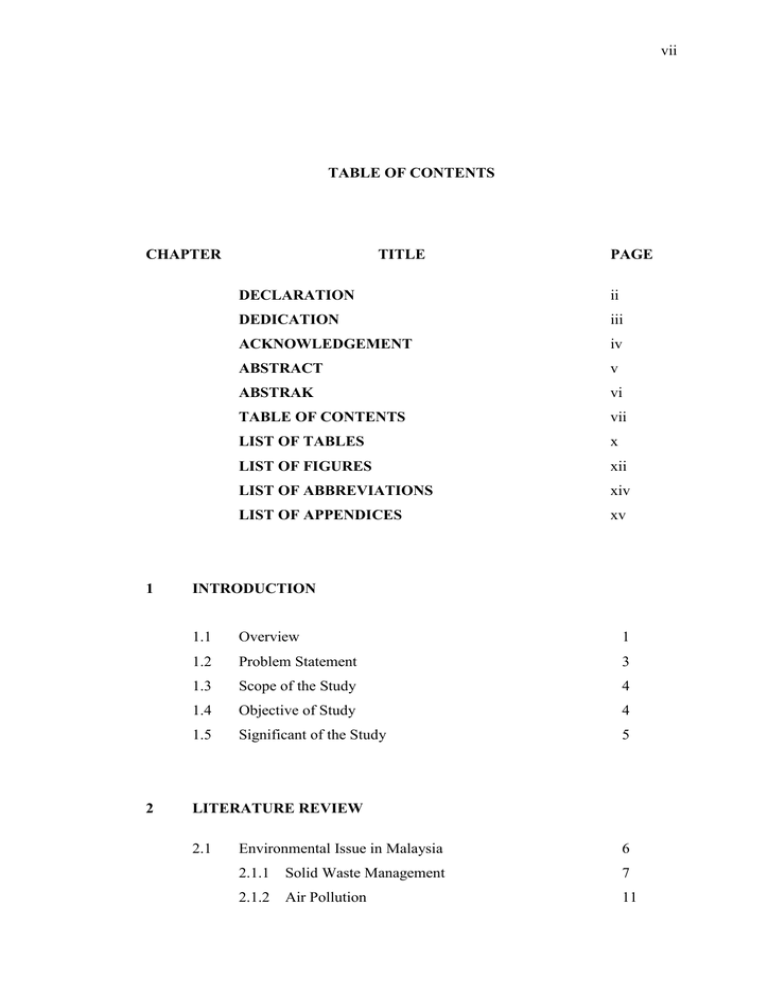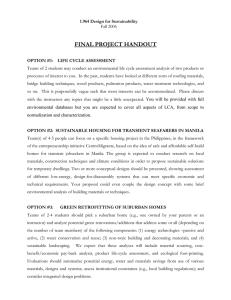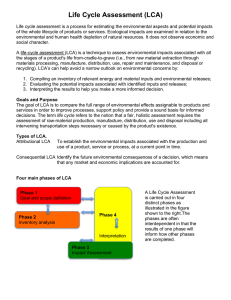vii ii iii iv
advertisement

vii TABLE OF CONTENTS CHAPTER 1 2 TITLE PAGE DECLARATION ii DEDICATION iii ACKNOWLEDGEMENT iv ABSTRACT v ABSTRAK vi TABLE OF CONTENTS vii LIST OF TABLES x LIST OF FIGURES xii LIST OF ABBREVIATIONS xiv LIST OF APPENDICES xv INTRODUCTION 1.1 Overview 1 1.2 Problem Statement 3 1.3 Scope of the Study 4 1.4 Objective of Study 4 1.5 Significant of the Study 5 LITERATURE REVIEW 2.1 Environmental Issue in Malaysia 6 2.1.1 Solid Waste Management 7 2.1.2 Air Pollution 11 viii 2.1.3 Water Pollution 14 2.2 Life Cycle Assessment (LCA) 15 2.3 Application of LCA 21 2.4 LCA and ISO 14000 24 2.4.1 ISO 14000 Series 26 2.5 2.6 3 and Developed Country 29 2.5.1 LCA Activities in Thailand 30 2.5.2 LCA in Malaysia 31 2.5.3 LCA in Japan 34 2.5.4 LCA in Germany 34 2.5.5 LCA in Europe and the United States 36 Environmental Friendly Product 36 2.6.1 Eco-labelling 37 2.6.2 Objectives of Ecolabelling 41 2.6.3 Ecolabeling in Malaysia 41 METHODOLOGY 3.1 Introduction 43 3.2 Data Collection 45 3.2.1 Primary Data 45 3.2.2 Secondary Data 46 3.3 4 Overview of LCA Implementation in Developing Research Design 46 3.3.1 Preliminary Data Collection 46 3.3.2 Data Collection 47 3.3.3 Result Analysis 48 3.3.3.1 Data Interpretation 48 DATA DATA AND RESULT ANALYSIS 4.1 Introduction 50 4.2 Questionnaire (Descriptive Analysis) 51 ix 4.2.1 Background of Respondent 51 4.2.2 Awareness and Knowledge Of LCA 54 4.3 Reliability Test 60 4.4 Inferential Statistical Analysis 60 4.4.1 Bivariate 61 4.4.1.1 Awareness of LCA 61 Regression 64 4.4.2.1 Awareness of LCA 64 4.4.2.2 Recyclability of Product 65 4.4.2 5 CONCLUSION AND RECOMMENDATIONS 5.1 Conclusion 67 5.2 Recommendations 69 REFERENCES 71 APPENDIX 75 x LIST OF TABLES TABLE NO. 2.1 TITLE PAGE Percentage of solid waste component from residential and commercial 8 2.2 Environmental factors to be considered in LCA 18 2.3 The description of the LCA component 19 2.4 The description of the components of LCA according to EPA, 2006 21 2.5 Benefits of implementing life-cycle concept 23 2.6 The description of ISO LCA standard and technical report 27 2.7 Evolution of eco-labelling and beginning of the National LCA Project in Malaysia 32 2.8 Some of organization of ISCZ 33 2.9 The definition of Voluntary Environmental Performance Labelling 39 3.1 Elaboration of section in the questionnaire 47 3.2 Five level of Likert scale 48 4.1 Number and category of production in Taman Universiti 51 4.2 Frequency and percentage of respondents 52 4.3 Frequency distribution towards knowledge of LCA 55 4.4 Reliability Statistics 60 4.5 Data Correlation for awareness 61 4.6 Data Correlation for product recyclability 62 4.7 Data Correlation 63 4.8 Data Correlation 63 xi LIST OF TABLES TABLE NO. TITLE PAGE 4.9 Models for awareness 64 4.10 Model summary for Awareness 65 4.11 Model for recyclability of product 66 4.12 Model summary for recyclability of product 66 xii LIST OF FIGURES FIGURE NO. TITLE PAGE 1.1 Location of study area 4 2.1 Industrial air pollution sources by states 12 2.2 Number of Registered vehicles, 2005-2006 13 2.3 The industrial System 16 2.4 A complete life cycle 17 2.5 Life cycle assessment stages and system boundary 17 2.6 The LCA conceptual model 19 2.7 Phases of LCA 20 2.8 ISO and development of environmental management tools 25 2.9 Logo of Blue Angel Scheme, Federal Environment Agency, Germany 38 2.10 Type I ecolabel. Multiple criteria, third party program 40 2.11 Type II ecolabel. Selft-Declared Environmental Claims such as compostable, degradable, recyclable, reduced energy consumption and reduced water consumption 2.12 40 Type III ecolabel. Environmental Declaration. An example of Report card on environmental performance from cradle to grave 40 3.1 The overall processes involved in the project 44 4.1 Manufacturer based on their type of production 52 4.2 Market target of the products. 53 4.3 Percentage of recyclability of the product produced from light industry at Taman Universiti 54 xiii LIST OF FIGURES FIGURE NO. TITLE PAGE 4.4 Consideration to perform LCA 56 4.5 Consideration of green product 56 4.6 Tendency to join the standard development process 57 4.7 Implementation of LCA should be compulsory 58 4.8 Government should provide LCA training and 4.9 more information 58 Medium preferred to deliver information of LCA 59 xiv LIST OF ABBREVIATIONS LCA - Life Cycle Assessment MSW - Municipal Solid Waste DOE - Department of Environment EPA - Environmental Protection Agency SETAC - Society of Environmental Toxicology and Chemistry ISO - International Organization for Standardization TC - Technical Committee EMS - Environmental Management System LCI - Life Cycle Inventory LCIA - Life Cycle Impact Assessment GP - Green Productivity TEI - Thailand Environment Institute SIRIM - Standards and Industrial Research Institute of Malaysia SIRIM QAS - SIRIM Quality Assurance Service ISCZ - Industry Standard Committee MNRE - Ministry of Natural Resources & Environment EU - European Union MICCOS - Malaysian International Commodities Conference CFC - Chlorofluorocarbon xv LIST OF APPENDICES APPENDIX. TITLE PAGE A Set of Questionnaire 75 B Anova Table for Model 1 (Awareness) 78 C Anova Table for Model 2 (Awareness) 79 D Anova Table for Model 1 (Recyclability) 80 E Anova Table for Model 2 (Recyclability) 81



